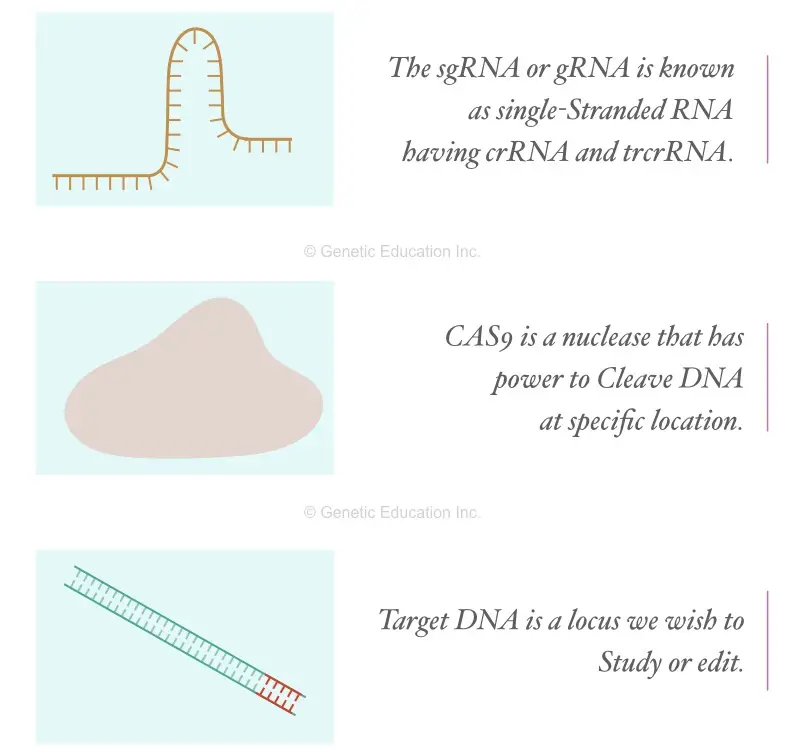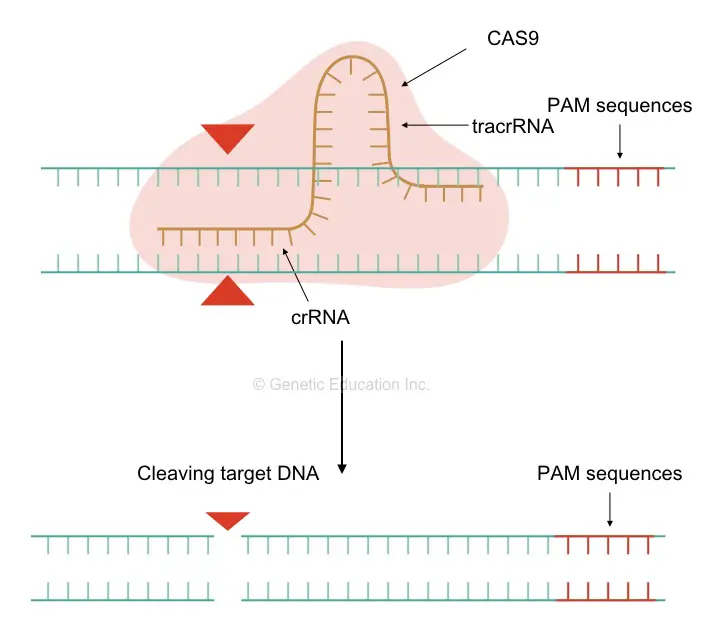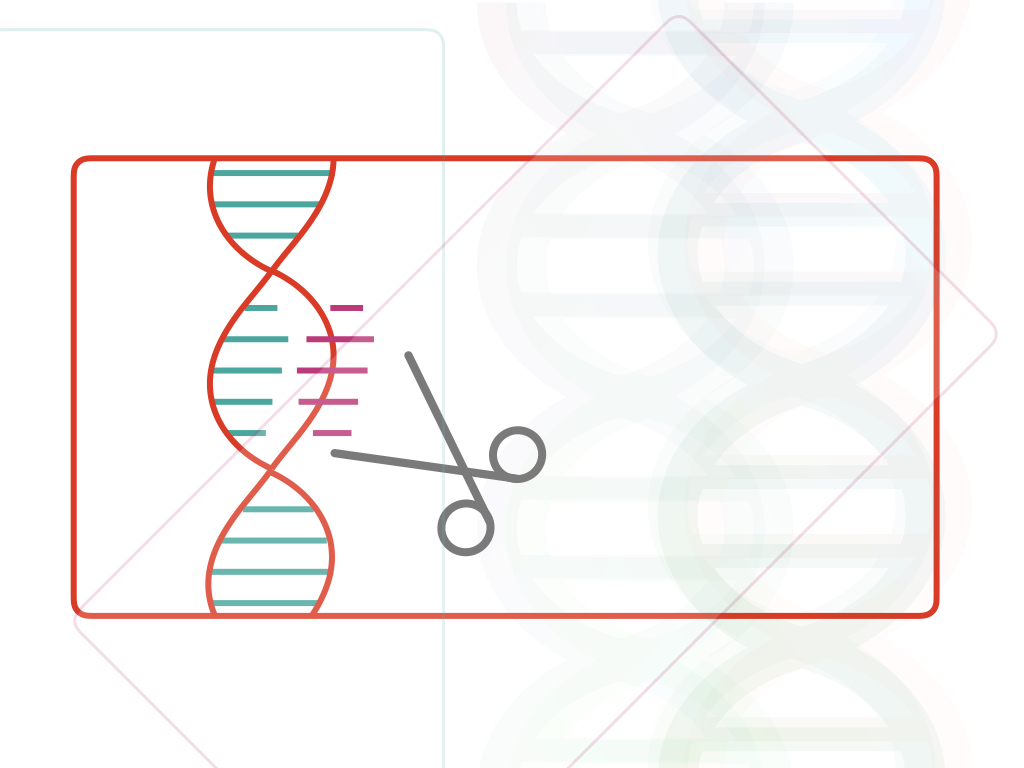“CRISPR CAS9 is a revolutionary recombinant/ gene-editing technique used in medical research, disease diagnosis, plant research and agriculture.”
The era of recombinant DNA technology or more precisely we can say genetic engineering was evolved during the ’70s, however, one of the best products of gene editing which is the CRISPR CAS9 gene editing was evolved late in the ‘20s.
It allows editing in a target genome at a specific location using the CAS9 nuclease. To establish this holly purpose the system uses the gRNA- guided RNA which leads the nuclease (CAS) to a specific location.
CRISPR is Clustered Regularly Interspaced Short Palindromic Repeats; was first reported in bacteria that use it for defense purposes. The CRISPR sequence actually consists of a fragment of a previously infected virus between the palindromic sequence (which makes the CRISPR) that stimulates the CAS to destroy the same virus when infect in the future.
So basically it’s a kind of alarm set in bacterial memory. The bacteria smartly use it to survive. The concept scientists use to edit (either remove or insert) a part of the genome artificially.
That’s what the CRISPR CAS9 is! You can read our previous article to learn more: What is gene editing and CRISPR-CAS9?
Imagine if we can cut and remove a faulty or mutated part of a gene, we can cure a disease, right!
That’s what a CRISPR CAS9 can do. And not only that, it has way more applications than we think of. It has potential applications in medical science, disease diagnosis, cancer, plant research, agriculture, constructing GMOs and other diverse fields. So basically it can not only cure the disease but can also disable infective parasites or improve crop quality and yield.
Here in the present article, I will enlist and explain all the possible applications of CRISPR CAS9. I hope you will like this article, but before that do check our previous article first.
Stay tuned,
Key Topics:
Applications of CRISPR CAS9 in medical science:
Scientists are looking forward to using this precise tool to cure genetic, infectious and other disorders including cancer. The tool can cure or prevent inherited genetic disorders such as sickle cell anemia, thalassemia, Huntington’s disease and a lot more.

Inherited genetic disorders:
Previously it was difficult to treat hematopoietic diseases which can be treated well by manipulating hematopoietic cells using the CRISPR-like techniques.
Recently the CTX001 therapy was given to sickle and thalassemia patients in whom amazing recovery results were shown. A single point mutation in the beta-globin gene can be ‘reprinted or ‘repaired’ through the present technology.
It provides therapeutic solutions for non-curable conditions like Huntington’s disease or muscular dystrophy. Huntington’s disease is a neurological condition associated with cognitive, neurological and developmental problems (broadly).
The HTT gene encodes the Huntington gene when mutates, accumulates in the surrounding tissues and produces serious complications. Studies on mice models suggest that the CRISPR CAS9 gene editing is up to 90% effective in the case of Huntington’s disease.
The same promising results are obtained in the case of Duchenne muscular dystrophy which is a genetic condition that largely affects the muscle cells. Studies suggest that when a healthy dystrophin gene is introduced in the affected mice model and treated with the CRISPR CAS9, positive outcomes are obtained.
Meaning, CRISPR collects the information of the correct gene and repairs the faulty gene and/or replaces it. Scientists are using the same approach to study other muscular dystrophies and genetic disorders like neurofibromatosis.
Notedly, a muscular dystrophy tool like CRISPR-Cpf1, gives promising results that I think we will discuss separately. In addition, scientists are looking forward to using this novel approach for alpha1-antitrypsin deficiency, hearing loss, other hematopoietic diseases and blindness.
Infectious disease:
Infectious viral diseases like HIV can also be treated & cured and is now a targeted research subject in the new trends of the CRISPR era. Effective results against HIV are obtained too using the CRISPR way.
Several such ways are to block the receptor using which, the virus enters. A few patients’ case studies showed that when a targeted mutation is introduced in the CCR5 or CXCR4 receptors, which are potential binding sites for HIV, the rate and intensity of infection decreases.
Besides, other approaches for the same are also reported in other studies, one such study shows that using the CRISPR technique, the viral replication cycle can be blocked which eventually makes a full stop on their infectivity.
There are many ways to stop viruses from infecting cells and to abrupt their replication cycles. The use of target-specific CRISPR makes such therapies possible.
Insect-born disorders:
There are countless possibilities to use CRISPR-CAS9 to improve overall public health. Yet another application shows that a unique way can help to prevent insect-borne diseases, like Malaria or zika virus.
A simple approach named a “gene drive” outspreads the disease-resistant gene in the insect population which ultimately immediately prevents the spread. In another study, researchers used a way to construct genetically modified mosquitoes with a lower fertility capacity.
The gene drive approach uses a gene of disease resistance/ sterility, guided RNA and CAS. Scientists are finding yet new ways to use the tool effectively for the eradication of Malaria or Zika- like insect borne-disease.
Preventing cancer:
One of the most potential and promising approaches of the CRISPR-CAS9 is in preventing cancer. Huge research is ongoing to combat various types of cancer using different ways by only applying a single CRISPR mechanism.
Cancer is an uncontrolled cell growth that commonly occurs due to the abrupt activity of proto-oncogenes or oncogenes. The first CRISPR therapy to cure cancer was launched in 2019 at the University of Pennsylvania. Broadly, the genetic alteration was done in the T cells and immune cells that can potentially prevent cancer spread and was practiced in multiple myeloma and metastatic sarcoma. Studies on mice models suggest that researchers are getting excellent results against many cancer types.
Lung cancer, skin cancer, blood cancer and colon cancer can be effectively cured using variants of the CRISPR technique, however, the majority of treatments are now under preclinical trials and not approved yet.
CRISPR CAS9 and cancer is a huge research subject, so I think we will cover a separate topic after completing this one.
Moreover, presently, scientists are looking forward to using the present technique for metabolic disorders, diabetes, obesity, preventive blindness, chronic pain and tissue regeneration.
CRISPR as a diagnostic tool:
The therapeutic use of the CRISPR-CAS9 is well known, but do you know that it can also be used as a diagnostic tool? In recent years, the duo has been utilized to detect SARS-CoV-2 in the case of COVID-19.
FDA has given emergency approval to some techniques like the SHERLOCK and DETECTR CRISPR-CAS9 to use as a diagnostic tool. Broadly, the artificial crisper, CAS9 and gRNA collectively work to find out the viral nucleic acid present in the sample.
The technique has more accuracy and is simple to use and therefore scientists are looking forward to using it for detecting other pathogens as well. Notedly, the technique is comparatively costlier.
Applications of CRISPR in plant biology And Agriculture:
Not only in medical science and clinical science, but the CRISPR and related tools also have great utility in plant research, plant biology, crop improvement and agriculture. A gene of interest can be introduced, replaced or removed to achieve a desirable trait.
The CRISPR is used to achieve numerous goals in plant breeding, crop improvement and agriculture; some such goals are,
- Developing resistance against abiotic and biotic stresses.
- Improving metabolic pathways.
- Developing haploid seeds.
- Developing herbicide and insecticide resistance
- Producing male sterility
- Improving crop yield
- Improving crop quality
- Improving nutritional properties
Pathogenic attacks on a plant species cause huge economic losses every year. For example, Citrus Canker caused by Xanthomonas citri is a serious citrus plant disease. Researchers from the National Center for Citrus Variety Improvement, Southwest University and the Chinese Academy of Agriculture Science have developed a resistant citrus species using the CRISPR technique.
Another group of scientists has developed the same assay against the bacterial blight in rice.
Plant breeding and crop improvement:
Take a look at some of the examples:
Li et al., (2017/2018) have explained a CRISPR-CAS9 technique to develop thermosensitive genic male sterility and high lysine content & elevated protein digestibility in Maize and Sorghum, respectively.
The ZmTMS5 gene in maize and K1C gene in Sorghum were the target genes modified using the CRISPR gene knockout and gene disruption technique. Okada et al., (2019) also have achieved male sterility in wheat using the same technique.
Salinity tolerance in rice was developed by Zhang et al., (2019) by inactivating the transcriptional factor sRR22.
Cold tolerance was developed in Dicotyledon Arabidopsis thaliana using gene disruption by Jia et al., (2016).
Ortigosa et al., (2018) achieved Bacterial speck resistance in tomatoes using the gene knockin technique by experimenting on the Tomato SlJAZ2 gene.
Soyk et al., (2017) achieved rapid flowering and early yield by a gene knockout in the tomato by experimenting on the SP5G gene.
Wang et al., (2017) developed drought resistance SIMAPK3 gene knockout in tomatoes.
Andersson et al., (2017) increased amylopectin content in potatoes by GBSS gene knockout.
Walts (2016) achieved a non-browning phenotype in Mushrooms by knocking out one out of six PPO genes.
All these phenotypes in various crops were achieved using different techniques and alterations of CRISPR CAS9.
Applications of CRISPR-CAS9 in animal and livestock research:
As we said, CRISPR has infinite potential applications. We can improve the quality of pig meat, strength and speed of horses, improve pet quality and equip animals for economical use.
Here are some of the good examples:
CRISPR for improving performance:
An Argentinian company Kheiron-Biotech has been working on developing novel horse species which will be faster and stronger. Various alterations of CRISPR technology have been applied to the myostatin encoding gene of horses to improve muscle growth.
The MSTN gene encodes for the myostatin gene is a negative regulator of muscle mass development. The Somatic Cell Nuclear Transfer technique was utilized to knock out the gene which ultimately increased the performance of horses (Moro L et al., 2020).
Fishery industry:
CRISPR can improve our food quality too. One such example is the CRISPR edited salmon that can culture twice faster compared to normal. The CRISPR edited sterile salmon is of good quality and more nutritious.
Datsomor A et al., (2019) used the CRISPR-CAS9 mediated ablation technique for Atlantic Salmon to improve the quality of fish oil. Fish oil containing Eicosapentaenoic acid and docosahexaenoic acid which can prevent inflammatory and cardiovascular diseases in humans. CRISPR-mediated elovl2 partial knockout technique helps to improve the fish oil quality.
Moreover, common fishery industrial problems such as reduced viabilities, parasitic disease, slow growth rate, decreasing fertility and improving quality and transportation are being addressed using the present gene-editing technique (Okoli et al., 2021).
Pet breeding:
Canis familiaris– A household dog is a good companion and friend of ours. New pet species, as well as improved pet breeds, can be developed using the CRISPR-CAS9.
New GMO pets can be developed and their performance can be improved by performing targeted gene-specific editing.
Besides, recent studies also indicated that CRISPR-mediated techniques are being used to improve the quality of animals, meat and food products.
Biological and medical research:
CRISPR is now an important tool in biological research used in the genome or gene editing, epigenetic studies, live imaging of DNA and transcriptional studies.
Genome editing tool:
CRISPR is an excellent, specific, successful and faster genome or gene-editing tool available nowadays. A target gene, gene sequence or polynucleotide chain can be removed, repaired or replaced.
homologous direct repair or non-homologous double-strand end joining are two common mechanisms that perform the joining of ends in this case.
We all know how it works, the guided RNA guides the nuclease to the site of action and do precise editing. CRISPR CAS9 as the genome-editing tool is more successful than the TALEN or ZFN.

Epigenetic studies:
Biological processes and metabolic activities highly rely on epigenetic modifications. Epigenetic modifications or gene expression have a great effect on the phenotype, for example, uncontrolled cell growth- cancer can be produced by the overexpression of some gene, led by any of the epigenetic factors either methylation, acetylation of histone modifications.
Gene expression can be controlled by CRISPR-CAS9 as well. For example some CASE like the dCas9- deactivated Cas9 can lift the transcription activity of some genes by binding at a specific location on a gene.
However, the mechanism is a bit complicated, scientists are trying to use it for genome-wide association studies and controlling many genes at a time. This external article may help you to learn more regarding the present topic: Genscript- Epigenetic Editing with CRISPR/Cas9.
Live DNA/mRNA imaging:
DNA or mRNA can’t be seen through naked eyes, though can be studied by the techniques like fluorescence in situ hybridization and fluorescence tagging of DNA binding proteins.
It certainly supports investigating biological processes like replication, transcription or recombination, unfortunately, live imagining of DNA or RNA isn’t an easy task.
There are two reasons for that, to hybridize DNA probes for FISH, we have to perform fixation while DNA binding proteins are limited to a specific location, and therefore can’t do live imaging for large-scale studies.
But fortunately, CRISPR-Cas9 can do that as well!
Inactivated cases like the dCas9, can bind to non-coding DNA and coding regions at many locations in the genome, and when tagged with fluorochrome, can give live imaging.
For example, we can investigate how chromatins are behaving during the cell cycle.
The same is also possible for the live investigation of the mRNA and gene expression studies and we can understand and study how various mRNA behaves.
Read more: Inside Chromatin: Definition, Structure, and Function.
Remember!!
CRISPR makes it possible for CAS to bind at various locations, we can synthesize various CRISPR as per the requirements and direct CAS to a specific location.
That’s the beauty of this technology!
Besides, these major applications in the research fields, it’s also applicable in,
- CRISPR mediated chromatin immunoprecipitation assay
- CRISPR libraries for screening or genetic screening
- Transcriptional studies like activation, repression and gene expression
Novel CRISPR-CAS9 applications:
CRISPR- CAMERA:
This looks like something interesting right!

The CRISPR can record events that a cell faces such as exposure to virus, light, antibiotics or other stress conditions. Not only that, it can record, store, erase or re-write events, meaning it can control a whole set of events, more precisely known as “stimuli”.
It can work for both prokaryotic and eukaryotic cells, however, to understand things better, research models are postulated on the bacterial cells only using the plasmids.
Put simply, three different plasmid types are inserted into the bacterial population, one resistant to the antibiotic, second sensitive to antibiotic and third altered having the CAS9 gene.
The CAS9 was designed in such a way that the enzyme destroys the plasmid when it experiences external stimuli, in this case, the antibiotics. Then the concentration of both types of plasmid can be measured to investigate the effect.
This technique can help in the future to study the life cycle of a cell, how a normal cell converts into a cancerous cell and how cell reactions to external factors. However, as of now, it is quite difficult to make it possible to use in solving a real-world problem.
CRISPR-CAS9 in producing bio-disease:
Some phototrophic algae can produce a bio-disease as a byproduct, the amount of final output was too small that couldn’t make it possible to overcome its cost; now using CRISPR-CAS9, the Algae genome modified in such a way that it can produce way more amount of bio-disease than it can produce previously.
That’s because of the targeted gene editing, CRISPR-CA9. The company named Synthetic Genomics has been working on this project for a long time.
Related article: The Curious Case of CRISPR-Babies.
Wrapping up:
So these are some of the most common, futuristic and amazing applications we will see in the future from CRISPR-CAS9 technology, however, some are just concepts now but will surely apply in upcoming years.
There is a lot of buzzes and work going on; like getting back extinct species; improving animal and plant genomes for economic purposes and preparing more model organisms for research.
CRISPR and related technologies are surely the future of genetics, gene therapy and for the whole world, who knows we can create good athletes, we can eliminate the disease from an embryo or can even produce a phenotype of what we wish in our baby.
Hoping CRISPR for the betterment of mankind!
References:
Moro, L.N., Viale, D.L., Bastón, J.I. et al. Generation of myostatin edited horse embryos using CRISPR/Cas9 technology and somatic cell nuclear transfer. Sci Rep 10, 15587 (2020). https://doi.org/10.1038/s41598-020-72040-4.
Datsomor, A.K., Zic, N., Li, K. et al. CRISPR/Cas9-mediated ablation of elovl2 in Atlantic salmon (Salmo salar L.) inhibits elongation of polyunsaturated fatty acids and induces Srebp-1 and target genes. Sci Rep 9, 7533 (2019). https://doi.org/10.1038/s41598-019-43862-8.
Okoli, A.S., Blix, T., Myhr, A.I. et al. Sustainable use of CRISPR/Cas in fish aquaculture: the biosafety perspective. Transgenic Res (2021). https://doi.org/10.1007/s11248-021-00274-7.
Li M., Li X., Zhou Z., Wu P., Fang M., Pan X., et al. (2016). Reassessment of the four yield-related genes Gn1a, DEP1, GS3, and IPA1 in rice using a CRISPR/Cas9 System. Front. Plant Sci. 7, 377. 10.3389/fpls.2016.00377.
Wang F., Wang C., Liu P., Lei C., Hao W., Gao Y., et al. (2016. a). Enhanced rice blast resistance by CRISPR/Cas9-targeted mutagenesis of the ERF transcription factor gene OsERF922. PloS One 11, e0154027. 10.1371/journal.pone.0154027.
Okada A., Arndell T., Borisjuk N., Sharma N., Watson-Haigh N. S., Tucker E. J., et al. (2019). CRISPR/Cas9-mediated knockout of Ms1 enables the rapid generation of male-sterile hexaploid wheat lines for use in hybrid seed production. Plant Biotechnol. J. 17, 1905–1913. .
Jia Y., Ding Y., Shi Y., Zhang X., Gong Z., Yang S. (2016. b). The cbfs triple mutants reveal the essential functions of CBFs in cold acclimation and allow the definition of CBF regulons in Arabidopsis . New Phytol. 212, 345–353.
Ortigosa A., Gimenez-Ibanez S., Leonhardt N., Solano R. (2018). Design of a bacterial speck resistant tomato by CRISPR/Cas9-mediated editing of SlJAZ2. Plant Biotechnol. J. 17, 665–673.
Soyk S., Muller N. A., Park S. J., Schmalenbach I., Jiang K., Hayama R., et al. (2017). Variation in the flowering gene SELF PRUNING 5G promotes day-neutrality and early yield in tomato. Nat. Genet. 49, 162–168.
Wang L., Chen L., Li R., Zhao R., Yang M., Sheng J., et al. (2017). Reduced drought tolerance by CRISPR/Cas9-mediated SlMAPK3 mutagenesis in tomato plants. J. Agric. Food Chem. 65, 8674–8682.
Andersson M., Turesson H., Nicolia A., Falt A. S., Samuelsson M., Hofvander P. (2017). Efficient targeted multiallelic mutagenesis in tetraploid potato (Solanum tuberosum) by transient CRISPR-Cas9 expression in protoplasts. Plant Cell Rep. 36, 117–128.Waltz E. (2016. b). Gene-edited CRISPR mushroom escapes US regulation. Nature 532, 293. 10.1038/nature.2016.19754.


